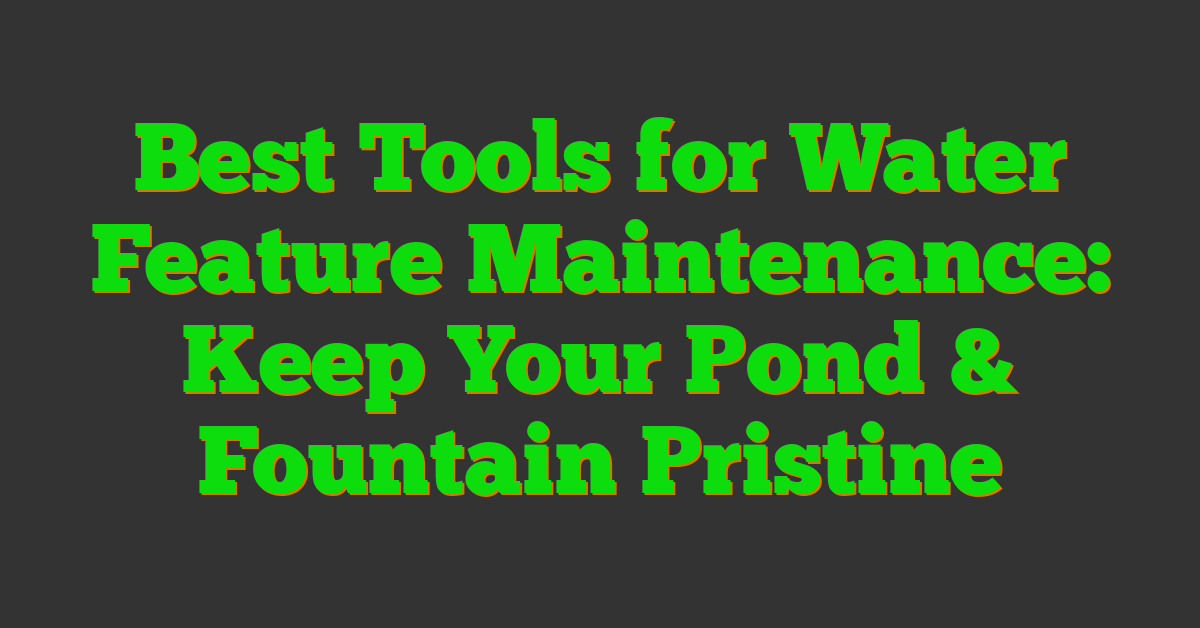Maintaining a stunning water feature can turn your backyard into a peaceful retreat. I love the soothing sounds and vibrant life that a well-kept pond or fountain brings to any space. But keeping it looking its best takes the right tools and a bit of effort.

Over the years, I’ve gathered some essential tools that make water feature maintenance a breeze. From skimmers to water testing kits, each tool plays a crucial role in ensuring your water stays clear and healthy. Whether you’re new to water gardening or looking to refine your techniques, these tools can help you achieve a beautiful and enduring water feature.
Essential Maintenance Tools
Maintaining a water feature requires specific tools to ensure its longevity and visual appeal. These essential maintenance tools streamline the upkeep process effectively.
Algae Removal Tools
Algae growth can cloud the water and disrupt the ecosystem. Effective algae removal tools include:
- Algae Scrapers: Safely remove algae from surfaces without damaging liners or stones.
- Algaecides: Chemical treatments that eliminate and prevent algae growth.
- UV Sterilizers: Utilize ultraviolet light to kill algae spores, reducing recurrence.
Debris Skimmers
- Surface Skimmers: Float on the water’s surface, capturing debris before it sinks.
- Manual Skimmers: Handheld nets or rakes for removing larger debris efficiently.
- Automatic Skimmers: Equipped with pumps, these skimmers continuously remove debris without manual intervention.
Cleaning Equipment
Keeping your cleaning equipment in good shape maintains the efficiency of your water feature. Here are the essential tools I rely on:
Pump Cleaners
Effective pump cleaners ensure optimal water flow and prevent clogs.
- Pump Brushes: Scrub the pump intake to remove debris and buildup.
- Maintenance Kits: Include replacement gaskets, seals, and cleaning solutions.
- Pump Vacuums: Extract sludge and sediments from the pump housing.
Filter Maintenance Tools
Proper filter maintenance keeps the water clear and healthy.
- Filter Backwashers: Reverse the flow to clean filter media and remove trapped particles.
- Filter Brushes: Clean the filter surfaces and remove accumulated debris.
- Pressure Gauges: Monitor filter pressure to determine when cleaning is needed.
- Replacement Media: Swap out old filter media to maintain filtration efficiency.
Inspection and Repair Tools
Regular inspections and timely repairs keep your water feature running smoothly. I use specific tools to identify issues early and fix them efficiently.
Water Testing Kits
Water testing kits ensure optimal water quality. They measure pH levels, ammonia, nitrites, and nitrates accurately. I rely on digital testers for quick readings and colorimetric kits for comprehensive analysis. Maintaining balanced water prevents algae blooms and supports aquatic life.
Leak Detection Tools
Detecting leaks early saves time and resources. I use pressure gauges to monitor system pressure and identify drops indicating leaks. Infrared cameras help spot hidden cracks or gaps in plumbing. Additionally, dye tablets highlight leak locations by coloring escaping water. Prompt repairs maintain water levels and feature integrity.
Choosing the Right Tools
Selecting the appropriate tools ensures efficient maintenance of your water feature. It enhances longevity and maintains visual appeal.
Factors to Consider
- Water Feature Size: Larger ponds require more powerful equipment, such as robust pumps and comprehensive filtration systems.
- Type of Water Feature: Ponds, fountains, and waterfalls each have specific tool requirements for optimal maintenance.
- Material Durability: Choose tools made from corrosion-resistant materials like stainless steel or durable plastics to withstand constant water exposure.
- Ease of Use: Opt for tools that are user-friendly and require minimal setup to streamline maintenance tasks.
- Energy Efficiency: Select energy-efficient pumps and lighting to reduce operational costs and environmental impact.
- Compatibility: Ensure tools are compatible with existing equipment to avoid additional expenses and complications.
- Maintenance Frequency: Tools should match your maintenance schedule, whether it’s daily, weekly, or monthly upkeep.
Budget-Friendly Options
- Manual Skimmers: Affordable and effective for removing debris without the need for electricity.
- Basic Water Testing Kits: Cost-effective kits provide essential measurements like pH and ammonia levels to maintain water quality.
- Inexpensive Algae Scrapers: Simple, low-cost tools help keep surfaces clean and prevent algae buildup.
- Multi-Use Cleaning Brushes: Versatile brushes can clean pumps, filters, and other equipment, reducing the need for multiple tools.
- Solar-Powered Pumps: Economical and energy-efficient, solar pumps lower electricity costs while maintaining water circulation.
- DIY Maintenance Solutions: Homemade remedies and tools can address minor issues without professional expenses.
- Second-Hand Equipment: Purchasing used tools in good condition offers significant savings while fulfilling maintenance needs.
Conclusion
Keeping my water feature in top shape has been a fulfilling experience. The right tools make all the difference in maintaining its beauty and serenity.
Seeing it thrive gives me so much satisfaction. I’m looking forward to continuing this journey and enjoying a peaceful backyard oasis.
















